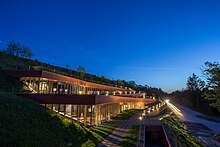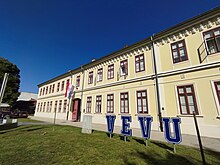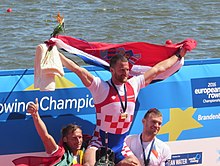Vukovar
Vukovar (pronounced [ʋûkoʋaːr]; Serbian Cyrillic: Вуковар, Hungarian: Vukovár, German: Wukowar) is a city in Croatia, in the eastern regions of Syrmia and Slavonia.
Since 1691, the town has been developing on the right bank of the Vuka, initially under the name Vukovarski otok (Insula Vukovariensis); since then, the Hungarian name Vukovar has supplanted the medieval Croatian name of the city.
The citizens of Vukovar received privileges from King Ludovik of Anjou, which included the holding of weekly fairs, which led to further stronger economic growth.
Part of the Serb community in the town and neighbouring villages was dissatisfied with the inclusion in the new autonomous Banovina leading them to present their disagreement in the 1939 Vukovar resolution.
[16] After the Croat-led coalition won the town election, a group of Croat high school students celebrated the victory by chanting pro-Croatian and anti-Yugoslav sentiments in the streets.
[16] The local newspaper Srijemski Hrvat, which was published in Vukovar from November 1939 to January 1941, showed a clear increase in Ustašist influence as the Kingdom of Yugoslavia approached its collapse.
[17] Although it was officially aligned with the Croatian Peasant Party (HSS), its editor, Luka Puljiz, was a committed Ustaša and leader in the movement's local cell.
[17] On 15 November 1939 Srijemski Hrvat discussed local Germans' support for the central government in Belgrade and invited them to back the Croatian Peasant Party-led regime in Zagreb instead.
[19] After 1941 Yugoslav coup d'état Luka Puljiz, editor of Srijemski Hrvat, received advance instructions on the procedure of the town capture following the Invasion of Yugoslavia.
[20] When the Independent State of Croatia was declared on 10 April 1941, following morning Puljiz group took control of Vukovar by seizing key locations such as the post office, police station, and town hall.
[23] More decrees suspended judiciary staff and public employees, giving the state the power to dismiss Jews, Serbs, and Croats with Yugoslav affiliations.
[25] Ustaša regime spread its ideology in Vukovar through various means, including the weekly newspaper Hrvatski Borac ("Croat Fighter"), which circulated from December 1941 to June 1942.
[29] Thirty of them were sent to the Jadovno concentration camp, while 15 were sentenced to death by a hastily convened traveling summary court and execution being carried at the Dudik site.
[30] Today, Dudik Memorial Park commemorates 455 individuals who were executed by the authorities of the Independent State of Croatia during the World War II in Yugoslavia.
[33] An additional monument was erected in Borovo Naselje to commemorate the soldiers of the Yugoslav and the Soviet Red Army who lost their lives in the liberation of the region between 8 and 12 April 1944.
[36] The company already reached its prewar employment levels in 1949, with the number of employees growing to 5,215 in 1955 and 10,572 in 1965, many of whom were from surrounding villages as well as from the rest of Slavonia, Vojvodina and other parts of Yugoslavia.
[46] The White Eagles, a Serbian paramilitary group led by Vojislav Šešelj, moved into the Serb-populated village of Borovo Selo just north of Vukovar.
[51] In the summer of 1991, Tomislav Merčep, at the time a leading official in the Croatian Democratic Union (HDZ) and Secretary of People's Defense, was put in charge of the town.
[52] Serbs have long voiced their concerns about the crimes committed against them in the months before the JNA took over the town after its fall in November of that year and the lack of accountability for the perpetrators.
[60] On 27 September 2007, the International Criminal Tribunal for the former Yugoslavia convicted two former JNA officers, Mile Mrkšić and Veselin Šljivančanin, for their involvement in the Vukovar massacre.
[70] UNTAES facilitated reintegration by gradual transition and invitation of Croatian officials so that in late 1996 President of Croatia Franjo Tuđman visited Vukovar for the first time where he participated in the meeting between Serb and Croat delegation.
[citation needed] According to the 2011 Croatian census, the Serb population of the city has exceeded one third, which is the legal prerequisite for the Serbian Cyrillic alphabet to gain constitutionally protected co-official status.
[81] Following the publication of 2021 census results, mayor of Vukovar nevertheless announced intention to scrap the minority language protections with some commentators criticizing the abolition of already acquired rights including the President of the Constitutional Court of Croatia Miroslav Šeparović.
Philip and James, the water tower, the birth house of Nobel prize winner Lavoslav Ružička, the Orthodox church of St Nicholas, the palace of Syrmia County etc.
Up until 1991 the museum had about 50 thousand exhibits in four separate divisions: The Heritage Museum displayed the history of Vukovar from prehistory to modern times and some of its most important collections included the items excavated at the archaeological site Vučedol and the Culture and History Collection, which contained documents, furniture, and pieces of art, and provided an authentic display of the life of the citizens of Vukovar and the Eltz family.
Among more than one thousand pieces of art the Collection contained the works of Vlaho Bukovac, Mato Celestin Medović, Ico Kršnjavi, Ivan Meštrović, Fran Kršinić, Emanuel Vidović, and many others.
Now that it is renovated, the Castle Eltz complex represents a unique museum and gallery, science, and multimedia centre, which preserves and presents cultural heritage as an element of national identity and the continuity of life in this area.
In addition to using state of the art technologies, multimedia and interactive content, the way of life on Vučedol culture localities, spreading through 12 European countries, is displayed.
Due to the particularity of its geographical position, primarily marked by the international waterway – Danube River, Vukovar represents a significant traffic hub of the main roads.
[citation needed] Vukovar is twinned with:[102] Bjelovar, Bjelovar-BilogoraSlavonski Brod, Brod-PosavinaDubrovnik, Dubrovnik-NeretvaPazin, Istria Karlovac, KarlovacKoprivnica, Koprivnica-KriževciKrapina, Krapina-ZagorjeGospić, Lika-Senj Čakovec, MeđimurjeOsijek, Osijek-BaranjaPožega, Požega-SlavoniaRijeka, Primorje-Gorski Kotar Sisak, Sisak-MoslavinaSplit, Split-DalmatiaŠibenik, Šibenik-KninVaraždin, Varaždin Virovitica, Virovitica-PodravinaVukovar, Vukovar-SrijemZadar, ZadarZagreb, Zagreb


































